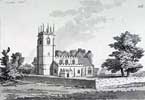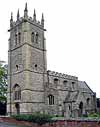For this church:    |
|
 View of the church from View of the church fromthe south-west, 1773 Image courtesy of the British Library |
Archbishop Herring’s visitation return of 1743 tells us that there were nine families attending the church and no dissenters; that the incumbent resided at Kelham and services were held every Sunday either morning or evening.
In 1779-80 the church underwent extensive restoration at a cost of £1,300, much of which was raised by public subscription.
In his revised edition of Robert Thoroton's Antiquities of Nottinghamshire (published in 1796) John Throsby made the following comments about the gargoyles at the church:
'I have seen many strange figures and forms without churches, originally intended to convey water from the roofs; some with horrid mouths, and many in the position of vomiting; but here is one too indelicate for either representation or description. It serves vulgar boys and men, the neighbourhood, to show women as a great curiosity, I am told, where the former fail not to laugh at the credulity of the latter.'
Maybe 21st century sensibilities are more robust, but no carving can be found now that could be described as ‘too indelicate to describe’.
The life of the Rev William Helps, rector of Hawton from 1798 to 1848, was one blighted by 'hopeless financial chaos.' In around 1807 he had opened a school in Hadley, a village to the north of London, that was 'used as a means of chiselling money out of wealthy parents'. It was not a success. Twenty years later, on 22 October 1828, he appeared before the Court for the Relief of Insolvent Debtors at Shire Hall, Nottingham, after having spent 'some months under confinement.' Although a beneficed clergyman with an income of £1,200 per annum his debts amounted to between £3,000 and £4,000 and he had 80 creditors. The Insolvent Debtors Act (1826) provided for the sequestration of livings and an application was ordered to be made to the Bishop of the Diocese. On 9 May 1830 a solicitor, representing the assignees appointed by the Insolvent Debtors' Court, appeared in Hawton church during the Sunday service and attempted to hand a sequestration document to Helps. The Stamford Mercury described the scene that ensued:
'LAW AND GOSPEL AT VARIANCE, or a Scene in Hawton Church, near Newark.—On Sunday morning last, Mr. G. Hopkinson, jun., of Nottingham, solicitor to the assignees appointed by the Insolvent Debtors’ Court, proceeded to the parish church of Hawton, to put into the hands of the Rev. W. Helps the sequestration, which the law requires "to be published in the church during the time of divine service." To the request of Mr. Hopkinson that Mr. Helps would read the same, the following answer was returned, "No, Sir, I shall not read it, neither shall I suffer the service to be interrupted by your reading it." At the end of the second lesson, Mr. Hopkinson proceeded to read the sequestration, while Mr. Helps commenced "O be joyful, &c." instead of "O be sorrowful." At the end of the service, Mr. Hopkinson, in further discharge of his duty, read the paper a second time, and afterwards affixed it to the church door, whence it was very speedily removed. The congregation consisted of eight persons, who left the church highly edified and instructed by the novelty of a lawyer turning parson, and the parson turned out by a lawyer.'
During restoration work in 1843-4 (at a cost of £1,645), the chancel was 'thoroughly repaired and a new roof added; and the whitewash, which for many years had obscured and disgraced the rich decorations and beautiful carvings, was taken away.' Perhaps to protect them from the Puritans, or because they were no longer considered to be suitable, they had been covered with many layers of plaster and whitewash. A reproduction in plaster of the whole Easter Sepulchre carving (including the tomb and door) appeared in the medieval court at Crystal Palace in the 1851 Great Exhibition.
The unoccupied tomb recess on the south side of the nave was walled up in 1845 and in the same year the Cambridge Camden Society produced plans, sections and elevations of the church and its ornaments. The work was done by the architect George Gordon Place of Nottingham. These plans contain an error in that two of the carved features on the sedilia have been transposed.
In 1851, the church had 160 free spaces and twenty others. No return was made of numbers attending the church services.
The church was reported in 1879 to be 'seriously dilapidated both inside and out, being neither wind nor water-tight, looking shabby and neglected'.
Restoration of the church was undertaken in 1879-80 by the Louth architect, James Fowler. Reporting on the reopening ceremony on 27 April 1880, the Nottinghamshire Guardian provides a comprehensive summary of the work:
'The alterations and restorations are complete and substantial. The whole of the interior of the building, which was formerly covered with plaster, has been completely re-chipped and the bare plaster removed. The outside has been pointed, and gives the church the appearance of having been newly built. Four doors, a new pulpit, reading desk, and seven pews in the body of the church of solid oak have been supplied. The floor of the church has also been re-flagged. The centre beam in the roof is new, but the roof itself has not been rebuilt, simply covered and releaded. All the arches on the church have been redressed, the whitewash with which they were formerly covered being removed. A recess on the left hand side of the chancel that was formerly bricked up has been reopened, a monument that stood there being removed farther up the left wall. The floor of the belfry is new, and the bells have been cleaned and rehung. The chancel has been greatly improved. The floor has been laid with Minton tiles, and new seats for the choir, and communion rails and table and chair, all of oak, give it a very pleasing appearance. The old sepulchre in the chancel has been renovated, and that without damage to its antiquity. The old rod [sic] screen still stands as a monument of by-gone ages, and looks with sombre aspect at the new decorations that surround it. The church stands in a pleasant position near to the road. The total cost of the alterations amounts to £1,154, and there still remains £250 to be collected for the purpose of building a new porch and vestry. The architect employed was Mr. Fowler, of Louth, and the builder Mr. Charles Baines, of Newark, and both gentlemen appear to have done their utmost to render this ancient place of worship comfortable.'
In 1887 the south porch, which replaces an earlier one, was added at the expense of a former parishioner.
In 1912 the church was said to have 154 seats, and 30 children on the Sunday School roll. There had been three baptisms over the past year.
In 1925 the west door was restored.
Another major restoration was carried out in 1965-66 at a cost of around £100,000, most of which was raised within the village.
The tower was restored in 2018-19 and a new steel bellframe for 10 bells installed. At the same time the bells were augmented to eight.






